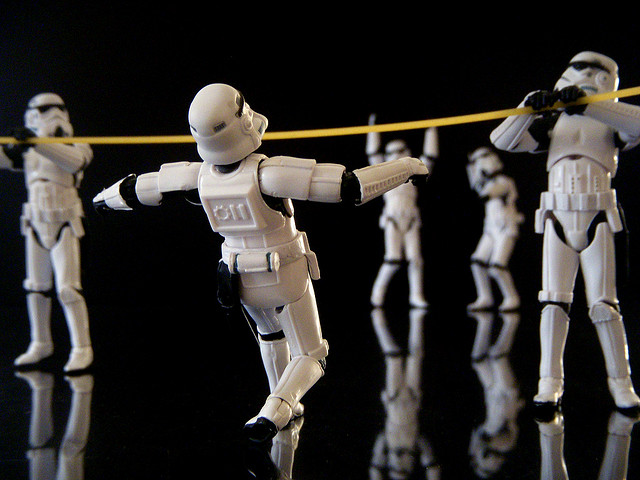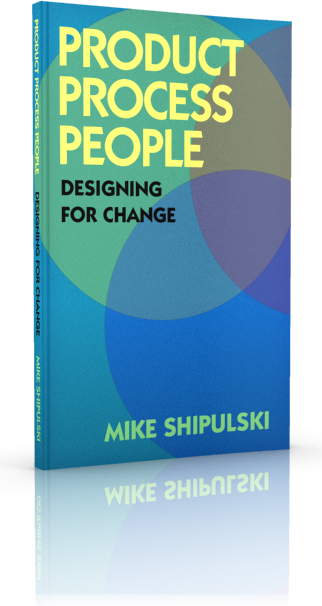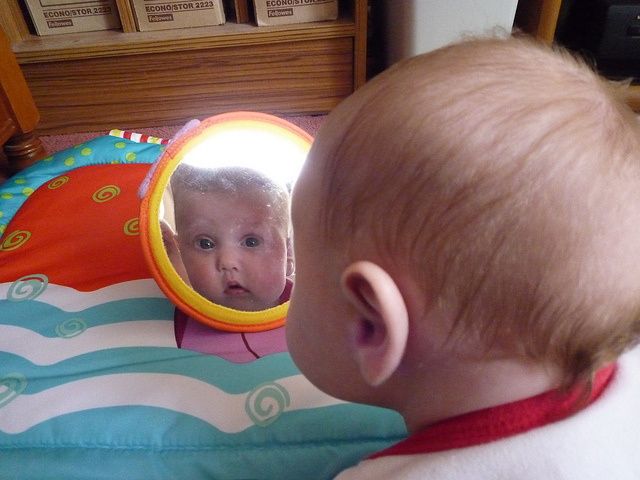Archive for October, 2013
The Threshold Of Uncertainty
 Our threshold for uncertainty is too low.
Our threshold for uncertainty is too low.
Early in projects, even before the first prototype is up and running, you know what the product must do, what it will cost, and, most problematic, when you’ll be done. Independent of work content, level of newness, and workloads, there’s no uncertainty in your launch date. It’s etched in stone and the consequences are devastating.
A zero tolerance policy on uncertainty forces irrational behavior. As soon as possible, engineering gets something running in the lab, and then doesn’t want to change it because there’s no time. The prototype is almost impossible to build and is hypersensitive to normal process variation, but these issues are not addressed because there’s no time. Everyone agrees it’s important to fix it, and agrees to fix it after launch, but that never happens because the next project is already late before it starts. And the death cycle repeats project after project.
The root cause of this mess is the mistaken porting of manufacturing’s zero uncertainly mindset into design. The thinking goes like this – lean and Six Sigma have achieved magical success in manufacturing by eliminating uncertainty, so let’s do it in product design and achieve similar results. This is a fundamental mistake as the domains are fundamentally different.
In manufacturing the same product is made day-in and day-out – no uncertainty; in product design no two product development efforts are the same and there’s lots of stuff that’s done for the first time – uncertainty by definition. In manufacturing there’s a revision controlled engineering drawing that defines the right answer (the geometry and the material) – make it like the picture and it’s all good; in product design the material is chosen from many candidates and the geometry is created from scratch – the picture is created from nothing. By definition there’s more inherent uncertainty in product design, and to tighten the screws and fix the launch date at the start is inappropriate.
Design engineers must feel like there’s enough time to try new things because new products that provide new functionality require new technologies, new materials, and new geometries. With new comes inherent uncertainty, but there are ways to manage it.
To hold the timeline, give on the specification and cost. Design as fast as you can until you run out of time then launch. The product won’t work as well as you’d like and it will cost more than you’d like, but you’ll hit the schedule. A good way to do this is to de-feature a subassembly to reduce design time, and possibly reduce cost. Or, reuse a proven subassembly to reduce design time – take a hit in cost, but hit the timeline. The general idea – hold schedule but flex on performance and cost.
It feels like sacrilege to admit that something’s got to give, but it’s the truth. You’ve seen how it goes when you edict (in no uncertain terms) that the timeline will be met and there’ll be no give on performance and cost. It hasn’t worked, and it won’t – the inherent uncertainty of product design won’t let it.
Accept the uncertainty; be one with it; and manage it. It’s the only way.
Accomplishments in 2013 (Year Four)
Accomplishments in 2013
- Fourth year of weekly blog posts without missing a beat or repeating a post. (251 posts in total.)
- Third year of daily tweets – 2,170 in all. (@mikeshipulski)
- Second year as Top 40 Innovation Bloggers (#12) – Innovation Excellence, the web’s top innovation site.
- Seventh consecutive year as Keynote Speaker at International Forum on DFMA.
- Fourth year of LinkedIn working group – Systematic DFMA Deployment.
- Third year writing a column for Assembly Magazine (6 more columns this year).
- Wrote a book — PRODUCT PROCESS PEOPLE – Designing for Change (Which my subscribers can download for free.)
Top 5 Posts
- What They Didn’t Teach Me In Engineering School — a reflection on my learning after my learning.
- Guided Divergence — balancing act of letting go and shaping the future.
- Innovation in 26 words — literally.
- Lasting Behavioral Change — easy to say, tough to do.
- Prototype The Unfamiliar — test early and often.
I look forward to a great year 5.
What Aren’t You Doing?
You’re busier than ever, and almost every day you’re asked to do more. And usually it’s more with less – must improve efficiency so you can do more of what you already do. We want you to take this on, but don’t drop anything.
Improving your efficiency is good, and it’s healthy to challenge yourself to do more, but there’s a whole other side to things – a non-efficiency-based approach, where instead of asking how can you do more things, it’s about how you can do things that matter more.
And from this non-efficiency-based framework, the question “What aren’t you doing?” opens a worm hole to a new universe, and in this universe meaning matters. In this universe “What aren’t you doing?” is really “What aren’t you doing that is truly meaningful to you?”
[But before I’m accused of piling on the work, even if it’s meaningful work, I’ll give you an idea to free up time do more things that matter. First, change your email settings to off-line mode so no new messages pop on your screen and interrupt you. In the morning manually send and receive your email and answer email for 30 minutes; do the same in the afternoon. This will force you to triage your email and force you to limit your time. This will probably free up at least an hour a day.]
Now we’ll step through a process to figure out the most important thing you’re not doing.
Here is a link to a template to help you with the process — Template – What Aren’t You Doing.
The first step is to acknowledge there are important things you’re not doing and make a list. They can be anything – a crazy project, a deeper relationship, personal development, an adventure, or something else.
To make the list, ask these questions:
I always wanted to ____________.
I always wished I could __________.
Write down your answers. Now run the acid test to make sure these things are actually meaningful. Ask yourself:
When I think of doing this thing, do I feel uncomfortable or or a little scared?
If they don’t make you a little uncomfortable, they’re not meaningful. Go back to the top and start over. For the ones that make you uncomfortable, choose the most important, enter it in the template, and move to the next step.
In the second step you acknowledge there’s something in the way. Ask yourself:
I can’t do my most meaningful thing because _______________.
Usually it’s about time, money, lack of company support, goes against the norm, or it’s too crazy. On the template write down your top two or three answers.
In the third step you transform from an external focus to an internal one, and acknowledge what’s in the way is you. (For the next questions you must temporarily suspend reality and your very real day-to-day constraints and responsibilities.) Ask yourself:
If I started my most meaningful thing tomorrow I would feel uncomfortable that ____________.
Write down a couple answers, then ask:
The reason I would feel uncomfortable about my most meaningful thing is because I __________. (Must be something about you.)
Write down one or two. Some example reasons: you think your past experiences predict the future; you’re afraid to succeed; you don’t like what people will think about you; or the meaningful stuff contradicts your sense of self.
Spend an hour a week on this exercise until you understand the reasons you’re not doing your most meaningful thing. Then, spend an hour a week figuring out how to overcome your reasons for not doing. Then, spend an hour a week, or more, doing your most meaningful thing.
Celebrating Four Years!
 Today is a celebration – four years of Shipulski On Design!
Today is a celebration – four years of Shipulski On Design!
To celebrate, I’m introducing my new book — Product Process People – Designing for Change.
And as a gift, I’m offering for free (pdf format) to my subscribers. If you’re a subscriber, click below to download the pdf. If you’re not a subscriber and you want the book, simply subscribe to my blog (see the box on the right) and download the pdf. (It’s the honor system.)
[wpdm_file id=3] Download it, read it, and share it with all your friends. (They don’t have to subscribe because you do.)
I hope the book helps you have a meaningful discussion about the future.
And for me, to help spread the message, if you download it please share it.
Thanks for reading, and I look forward to a great year 5.
Mike
Positivity – The Endangered Species
There’s a lot of negativity around us. But it’s not upfront, unadulterated negativity; it’s behind-the-scenes, hunkering, almost translucent negativity. And it’s divisive.
This type of negativity is so pervasive it’s almost invisible. It’s everywhere; we have processes built around it; have organizations dedicated to it; and we use it daily to drive action.
Take continuous improvement for example. It has been a standard toolset and philosophy for making things better. Yet it’s founded on negativity. It’s not anti-people, anti-culture negativity. (In fact lean and Six Sigma go on their way to emphasize positive culture as a key foundation.) It’s subtle negativity that slowly grinds. Look at the language: reduce defects, eliminate waste, corrective action, tight feedback loops, and eliminate failure modes. There is a negative tint. It’s not in your face, but it’s there.
I’m an advocate of lean and I have advocated for Six Sigma, both of which have moved the needle. But there’s a minimization thread running through them. Both are about eliminating and reducing what is. Sure they have their place, but enough is enough. We need more of creating what isn’t, and bringing to life things that aren’t. We need more maximization.
Negativity has become natural, and positivity has become an endangered species. When there’s a crisis we all come together instinctively to eliminate the bad thing. Yet it’s fourth or fifth nature to come together spontaneously when things go well. Yes, sometimes we celebrate, but it’s the exception. And it’s certainly not our first instinct. (Actually, I don’t think we have a word for spontaneous amplification of positivity. Celebration is the closest word I know, but it’s not the right one.)
Negative feedback is good for processes and positive feedback is good for people. Processes like when their flaws are eliminated, and people like when their strengths are amplified. It’s negativity for processes, and positivity for people.
There should be a rebalancing of negativity and positivity. For every graph of defect reduction over time, there should be a sister plot of the number of good things that happened over time. For every failure mode and effects analysis there should be a fishbone of chart of strengths and the associated actions to amplify them.
It’s natural for us to count bad things and make them go away, and not so natural to count good things and multiply them. Take at the meeting agendas. My bet is there’s far more minimization than maximization.
I usually end my posts with some specific call to action or recommendation. But for this one I don’t have anything all that meaty. But I will tell you how I’m going to move forward. When I see good work, I’m going to publicly acknowledge it and send emails of praise to the manager of the folks who did the good stuff. I’m going to track the number of emails I send and each week increase the number by one. I’m going to schedule regular meetings where I can publicly praise people that display passion. And I’m going to create a control chart of the number of times I amplify positivity.
And most of all I will try to keep in front of me that everything we do is all about people, and with people positivity is powerful.


 Mike Shipulski
Mike Shipulski